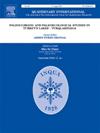伊比利亚西部边缘上古-第四纪海岸隆起:来自葡萄牙佩尼切海相阶地年代的启示
IF 1.8
3区 地球科学
Q3 GEOGRAPHY, PHYSICAL
引用次数: 0
摘要
本研究对发展成Peniche半岛(葡萄牙)的海相阶地阶梯进行了详细的地貌和地质年代学分析。Peniche半岛是位于西伊比利亚被动边缘中部的侏罗纪碳酸盐岩基岩岩岬。用形态和沉积学方法描述了海相阶地的水平,但也用ESR和u系列方法测定了年代。海洋露台楼梯包括六个凸出的高度,从4米(高于平均海平面,asl) (Tm6)到24-28米(Tm1),嵌入在海拔29-45米(Pm)的山顶波浪切割平台上。海相阶地沉积物由圆形巨石到鹅卵石和粗砂组成。测年结果显示,海相阶地阶梯跨越中晚更新世~ 900 ka。梯田可以被指定为一个单一的海平面高地,也可以被两个海平面高地重新占用。该台阶记录了非常低的隆升速率(0.04 ~ - 0.02 m/ka,整个更新世台阶的长期平均隆升速率为0.03 m/ka),是典型的被动大陆边缘。从区域上看,沿海阶地阶地典型分布在西伊比利亚被动边缘,其局部构造受下伏基岩地质和构造历史的影响。本文章由计算机程序翻译,如有差异,请以英文原文为准。
Plio-Quaternary coastal uplift along the western Iberian Margin: insights from dated marine terraces (Peniche, Portugal)
This study presents a detailed geomorphological and geochronological analysis of a marine terrace staircase developed into the Peniche Peninsula (Portugal), a rocky headland of Jurassic carbonate bedrock located in the central sector of the Western Iberian passive margin. The marine terrace levels are described morphologically and sedimentologically, but also dated using ESR and U-Series methodologies. The marine terrace staircase comprises six emerged levels ranging from 4 m (above mean sea level, asl) (Tm6) to 24–28 m asl (Tm1), inset into a summit wave-cut platform at 29–45 m asl (Pm). The marine terrace sediments are composed of rounded boulders to cobbles and coarse sands. Dating results reveal that the marine terrace staircase spans ∼900 ka across the Middle-Late Pleistocene. The terraces can be assigned to either a single sea-level highstand or a level that has been re-occupied by two sea level highstands. The staircase records very low uplift rates (0.04 to −0.02 m/ka; the longer-term mean rate for the entire Pleistocene staircase is 0.03 m/ka), typical of a passive continental margin. Regionally, coastal terrace staircases are typically found along the Western Iberian passive margin, with their configuration locally influenced by the underlying bedrock geology and tectonic history.
求助全文
通过发布文献求助,成功后即可免费获取论文全文。
去求助
来源期刊

Quaternary International
地学-地球科学综合
CiteScore
5.60
自引率
4.50%
发文量
336
审稿时长
3 months
期刊介绍:
Quaternary International is the official journal of the International Union for Quaternary Research. The objectives are to publish a high quality scientific journal under the auspices of the premier Quaternary association that reflects the interdisciplinary nature of INQUA and records recent advances in Quaternary science that appeal to a wide audience.
This series will encompass all the full spectrum of the physical and natural sciences that are commonly employed in solving Quaternary problems. The policy is to publish peer refereed collected research papers from symposia, workshops and meetings sponsored by INQUA. In addition, other organizations may request publication of their collected works pertaining to the Quaternary.
 求助内容:
求助内容: 应助结果提醒方式:
应助结果提醒方式:


